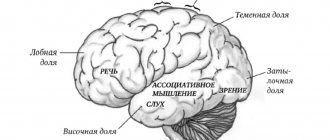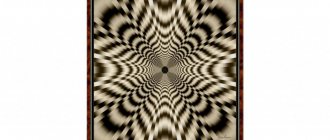Development of perception in preschool children. A person cannot live detached from the world; he feels and understands it with the help of hearing, vision, and tactile sensations. All information enters the brain and is processed efficiently. A preschooler must learn to perceive the world correctly in order to benefit from this for further development.
Features of the development of perception in a child
A preschooler perceives the world through active play, in which he learns and learns something new.
At a young age, preschool children cannot use their imagination; they use the knowledge they receive by using objects. So, if a frog is green, then for a child it can only be green. If an orange is orange, then another fruit of the same color is also an orange for the baby. Three-year-olds do not have a clear perception, they do not know how to analyze.
In the middle groups of kindergarten, pupils already have partial perception. They know colors, they know some geometric shapes, they can compare objects with each other in size and shape, but they do not understand time values. But they can and love to be creative. In many ways, getting to know the world and people for them is about accepting or not accepting appearance and character traits.
Older preschoolers already prefer to see than to hear a hundred times. Auditory perception lags behind visual perception. During this period, the child’s behavior and the qualities of his character are formed, so motivation is important when working with children of this age.
How do children of middle preschool age (4-5 years old) perceive the world?
By the age of 5, children achieve significant success in their ability to perceive various parameters of the world around them:
- There are 7 or more colors;
- Have an idea of light and dark tones, “warm” and “cold” shades;
- Know the basic geometric shapes (circle, square, triangle, rectangle);
- Can compare objects by size (large, smaller, small);
- They begin to form the concept of time (today, yesterday, tomorrow, minutes, hours, days, weeks), but they are not yet able to apply knowledge about these abstract concepts into the life of a four-year-old;
- The perception of other people depends on their popularity in society and their relationship with the baby. Mom will always be perceived by the baby as the kindest and most beautiful.
Types of perception
A preschooler gets to know the world based on:
- visual analyzer,
- opportunity to hear
- thanks to touch.
So, with the help of hearing, a child hears speech, music, and various sounds. Sounds surround the child everywhere: at home, on the street, in kindergarten. With the help of vision, the baby evaluates the world around him, including possible danger. He also learns to love the beauty of his native land, works of art, and other beautiful things, without which a person’s life would be dull. A child's tactile abilities allow him to become familiar with the different textures of the materials around him: hot asphalt in summer or cold icicle in winter - everything matters. These tactile sensations are remembered.
Levels of development of perception in a preschooler
Perception in preschoolers has three stages.
The first is subject. Children of primary preschool age can only name objects, but are not able to characterize them.
The second is descriptive. From the age of five, preschoolers can describe what they see, compare it with something, and give an assessment.
The third stage is interpretive. Kindergarten graduates can come up with whole stories, fairy tales, supplement the story with their own feelings, and draw conclusions. He is already using the knowledge he has acquired and trying to apply his experience. This practice will be useful for children in first grade.
Exercises and games to develop perception in preschoolers
To develop perception in preschoolers, the child’s age must be taken into account. After all, what is understandable to a five-year-old will be very complex and inexplicable for three-year-olds. In particular, musical games with noise effects of natural sounds are suitable for children of middle and older groups, but not younger ones. It will also be difficult for young children to play with the shades of colors. But they will be interested in finding objects of the desired shape and specific color, and beating the rhythm. Older preschoolers can be offered complex game programs for the development of different perceptions.
Development of auditory perception
There are many sounds in the world, and each object and phenomenon has its own characteristic sound. The child must learn to understand these sounds. How the rain makes noise, how the leaves rustle, how the locomotive hums, how the birds chirp - all this is important. Toddlers do not perceive natural sounds well, but older preschoolers are already able to hear characteristic features if time is devoted to the development of auditory perception. Why is it important to learn to hear? Because without this it is impossible to speak correctly and clearly.
With kids you need to play games that develop a sense of rhythm. Sentencing handclaps are a great idea. With older children, you can already explore the sounds of nature. Walks, excursions through the forest, and the street are suitable for this.
Auditory perception is impossible without auditory attention. Therefore, you need to play “Deaf Telephone” with preschoolers, where you need to activate your hearing.
Another interesting game that children will enjoy is “Radio Theatre”. A preschooler hears a fairy tale that is read role-playing. And the child must find out which character owns the voice, intonation, and phrase.
How to develop auditory perception in children: VIDEO
Development of visual perception
At primary preschool age, children already know the names of primary colors. For them, color perception lives in four colors: red, yellow, blue and green. All other shades are unimportant. In addition, the main assessment is “beautiful” and “ugly,” and the child’s subjective opinion plays a role here.
Later, the child, recognizing new colors and learning to understand them and their shades, begins to more realistically evaluate what he sees. To develop visual perception, you can also suggest drawing a picture using dots. An interesting game will be in which the player is asked to walk through a “labyrinth”. The labyrinth is the path shown in the picture.
There may be a character on one side of the maze, and a character's goal on the other. For example, a child is asked to help a bear cub get to a barrel of honey. So, on one side of the maze there is a bear cub, on the other there is a barrel. The child must lead his finger along the drawn path, looking for the right path. It will also be useful to invite children to find the shadows of any character depicted in the picture. Attentiveness and the ability to notice little things are what this game develops.
Games to develop visual perception: VIDEO
Development of visual perception and attention in children with disabilities: VIDEO
Development of phonemic awareness
Development of perception in preschool children. Phonemic awareness includes:
- the ability to hear and identify sounds in words,
- the ability to determine where exactly a particular sound is located in a word,
- the ability to distinguish words that are similar in sound but different in meaning.
If a child knows how to do this, he will be able to learn to speak correctly, which means he will not have problems at school.
Games where children learn to recognize objects by sounds are well suited for the development of phonemic awareness. For example, a whistle whistles, cereal rustles, water makes noise, a car hums. It is also important to teach your child to hear soft and loud sounds and recognize them correctly. Another feature of phonemic perception is the understanding of the distance or proximity of sounds.
To develop phonemic awareness, the teacher often uses audio recordings with sounds of nature, and then invites children to answer what exactly they heard, offering pictures that depict various natural phenomena.
A good game would be to invite preschoolers to find out what is in the box. The box is shaken, and by the sound the children try to find out what is hidden.
To help children learn to identify the source of a sound, you can play “Bell.” In this case, the presenter places a blindfolded player in the center of the hall, and hands one of the children a bell. The child is calling. The player wearing the blindfold must indicate the direction from which the sound is coming.
Techniques for the development of phonemic hearing: sound-letter analysis in children with ODD: VIDEO
Games for developing phonemic awareness: VIDEO
Development of musical perception
Development of perception in preschool children. If very young children distinguish music by contrast, then by the age of three they already remember individual melodies they like. By the age of five, children not only sing songs, but also understand the musical mood and can distinguish the tempo of music, dynamics, duration of sounds, and rhythm. Older preschoolers are able to distinguish musical works by emotional coloring and know the terms. Children can even tell you how they feel when they hear a particular tune.
Many teachers believe that in preschool age it is useful for children to listen to classical works: N. A. Rimsky-Korsakov, P. I. Tchaikovsky, D. D. Shostakovich and others. It is also useful to introduce children to folklore. Folk dances and songs are a good opportunity not only to introduce preschoolers to folk art, but also to develop children’s musical perception.
The third step is to teach the children songs written specifically for this age. These can also be songs from children's films and cartoons. Moreover, all songs must be in genres known to children.
Development of tactile perception
Peculiarities of perception in early preschool age (3-4 years)
The perception of 3-4 year old children is characterized by specificity and lack of clarity. The main parameters of perception in early preschool age are color, shape and size. Most often, children pay attention to the most striking of these signs, and the rest of the details are guessed by them. For example, seeing buttons with numbers on the TV remote control, children often decide that it is a telephone. It is interesting that three-year-olds do not recognize even the closest people if they are dressed in carnival costumes. At this age, children clearly distinguish primary colors (red, yellow, blue, green). Little-known shades are perceived as unimportant signs, and therefore are often simply ignored. However, kids learn quickly and remember everything on the fly. The more color standards you introduce your child to, the brighter the baby’s perception will be. Sometimes children evaluate the color characteristics of objects as “beautiful” and “ugly”, so in drawing you can see the child’s color preferences, and not real images of objects.
The properties of objects for younger preschoolers are inseparable from the things themselves, so they are firmly fixed in perception. For example, a baby knows that a cucumber is always green, and can call zucchini, avocado, and green beans cucumbers.
In children of this age, their perception of space is formed through actions with objects. A 3-year-old child is just beginning to distinguish between the concepts of “far” and “close”, so he has difficulty assessing the size of distant objects. For example, looking at the panorama of the city, a child may well think that the houses are toy. To develop the baby’s spatial understanding, you need to pay his attention to his own body (the child will quickly remember that the legs are below, the head is above, and the arms are at the side), and also more often give the child requests indicating the direction (for example, “turn right” , “take the candy from the top shelf” and so on).
Methods for developing different types of perception
Here are several methods for developing perception of different types.
Size, color and shape
In this case, children are asked to take out objects of only one color from the boxes. Or suggest taking out only square objects, or only round ones. You can prepare boxes painted in different colors, and in them the child must put objects of the color in which the box is painted.
What's lost?
In this game, not only vision and attentiveness work, but also thinking. The child is asked to look at a picture showing different objects. But they are not finished yet. For example, a bicycle is missing a wheel, and a house has no windows. The child must tell what is missing.
Smell and guess
Smell works in this game. The child is blindfolded, in front of him are vegetables and fruits, and other products that the player must name, guided by smell.
Magic sound
A game that awakens the imagination and ears. Child with closed eyes. The presenter plays sounds, including the audio system: the sound of rain, the sound of a steam locomotive, the chirping of birds, etc. The child names who the sounds belong to.
Tactile riddle
There are objects in the container. The child, without looking, must determine by touch what it is. Objects must be of different sizes, shapes, smooth or rough.
Perception disorders and causes
Development of perception in preschool children. Perception disorders are the inability to correctly perceive surrounding sounds and objects. Such a person is disoriented; he cannot really assess the reality around him.
The causes of perception impairment may be:
- pathology of the central nervous system, including due to diseases;
- mental disorders;
- reaction to taking complex medications such as antidepressants, antivirals and others;
- drug addiction, including congenital;
- trauma resulting in damage to the nervous system;
- physical and mental fatigue of the body;
- visual defect.
A child suffering from perception disorders needs to work with specialists who will create an individual program. But at the same time, the family can help solve the problem in the following ways:
Follow a daily routine
Get up and go to bed at the same time, eliminate those actions that cause fear and emotional stress.
Light
The child does not perceive the shape and color of objects well, and in poor lighting it becomes even worse. Therefore, the light should be bright, but soft.
Colors
So that the nervous system does not experience additional stress, it is necessary that the child’s room has as little gloss and ornaments as possible and as many solid colors as possible.
Daily activities to develop perception
Games to develop the ability to understand the size, size and shape of an object, as well as its color, and to develop sound and visual perceptions should be built taking into account the characteristics of children with disabilities. For example, you can offer to play such a game. It is proposed to insert an element of the same shape into specific puzzles. Of course, the child will not succeed right away, but over time he will experience small success. You can also use games that require tactile sensations. Playing with sand is also calming and develops fine motor skills.
Types of information perception in children
Four types of perception: visual, auditory, kinesthetic, discrete.
The discovery of 4 types of information perception in children and adults was very interesting for me. And as a teacher I was doubly interested. After all, schooling for a child is mainly a process of perception and assimilation of the information offered. Depending on the characteristics of perception and processing of information, people can be divided into four categories. Visual learners are people who perceive most information through vision. Auditory learners are those who primarily receive information through the auditory canal. Kinesthetics are people who perceive most information through other senses (smell, touch, etc.) and through movements. Discrete people - their perception of information occurs mainly through logical comprehension, with the help of numbers, signs, and logical arguments. This category is perhaps the smallest among people in general. But for elementary and middle school students, this way of perceiving information is usually not at all typical. Why is it important to know how a student perceives information? During the lesson, the teacher can present information to children using all channels of perception: vision, hearing, and the kinesthetic channel. Then each of them has a chance to internalize at least some of these messages. This is usually what happens. This chance increases significantly if, for example, both the teacher and the student are visual (or auditory) learners. Unfortunately, there are few kinesthetics among teachers at all, and in middle and high schools there are practically none (except for physical education and labor teachers). The development of many important skills depends on which channel the child has. For example, reading or writing. The characteristics of mental work differ significantly (for example, the level of distractibility, the characteristics of memorization, etc.). If parents and teachers know which category their student belongs to, it is easier for them to build relationships with him. Much becomes clear: why problems with discipline arise, why we “speak a different language,” how to properly encourage a child or make comments to him, etc. Now briefly about how we can recognize a person’s leading channel for perceiving and processing information. If a child is in elementary school or middle school, conclusions are drawn mainly from observations. If this is a teenager or an adult, then you can also offer him a special questionnaire (self-diagnosis). What do you need to pay attention to? Dictionary of communication. In his speech, a visual person uses nouns, verbs, adjectives, mainly related to vision (look, observe, a picture, at first glance, transparent, bright, colorful, as you can see, etc.). The auditory language is characterized by the use of words related to auditory perception (voice, listen, discuss, silent, silence, loud, euphonious, etc.). The kinesthetic vocabulary mainly includes words that describe feelings or movements (grasp, soft, warm, touch, flexible, good smell, etc.). Direction of view. When communicating, visual learners look primarily upward, auditory learners look along the midline, and kinesthetic learners look downward. Features of attention. It is generally difficult for a kinesthetic person to concentrate his attention, and he can be distracted by anything; auditory learners are easily distracted by sounds; The noise practically does not interfere with the visual. Features of memorization. The visual person remembers what he saw, remembers with pictures. Auditory - what was discussed; remembers by listening. A kinesthetic learner remembers the general impression. Remembers by moving. There are also such characteristics as preferred posture, body movements, timbre of voice, rate of speech. However, the existing opinions on these points are still quite contradictory. And how many opportunities teachers and parents have to observe different types of students in their daily activities! For example, see who writes down their homework. Let's say it's written on a chalkboard. Visual: obediently open the diary and write down, or rather, copy from the board, what is assigned for homework. He prefers to have the information he needs than to ask others. He will easily perceive it written on the board. Auditory: if he wants to write down his homework at school, he will most likely ask his neighbor at his desk what was assigned. From hearing, he will write down this information in his diary. At home he can “get on the phone” and find out what is assigned from his classmates. Or asks his parents to do it and tell him. Kinesthetic: most often he rummages through his briefcase for a long time, takes out textbooks from there, finds the necessary pages and circles the numbers of the necessary exercises right in the textbooks. Observing the behavior of children during recess will give a lot. Visual: most often stays in class if most students leave it. For him, the main thing is the opportunity to calmly plunge into his visual images. But he may be disturbed by noisy dialogues of auditory learners or active games of kinesthetic learners. Then he will prefer to go out into the corridor, where he will watch other children or look at information on the walls. Auditory learners use recess to talk and make noise. Especially if in the previous lesson you had to “keep your mouth shut.” For a kinesthetic learner, a change is needed to warm up and move around. What do these observations indicate? You should not force all children to dance in circles or listen to quiet music during recess. Each child instinctively chooses the method of recuperation that suits him. You also need to approach each of them individually in academic work. Experts say: - a visual person can be required to quickly solve problems; - from the auditory - immediate repetition of the material he heard; - it’s better not to expect either one or the other from a kinesthetic learner - he needs a different attitude, he needs more time and patience on the part of teachers and family! When doing work in class or at home, it is recommended: - allow the visual student to have a sheet of paper on hand, on which he can draw, shade, draw, etc., in the process of comprehending and memorizing the material; - do not make comments to the auditory student when he makes sounds or moves his lips in the process of memorization - this makes it easier for him to cope with the task; - kinesthetics should not be forced to sit still for a long time; be sure to give him the opportunity for motor discharge (go for chalk, a magazine, write on the board, at home - go to another room, etc.); Memorizing material is easier for him while moving. Of course, it is very important to communicate with the child in “his language”: - with a visual learner using words that describe color, size, shape, location; highlighting different points or aspects of content with color; recording actions using diagrams, tables, visual aids, etc.; - with the auditory, using voice variations (volume, pauses, pitch), reflecting the rhythm of speech with the body (especially with the head) at a speed characteristic of this type of perception; - with a kinesthetic student using gestures, touches and the typical slow speed of thought processes; remember that kinesthetic learners learn through muscle memory; the more exaggeration, the better for memorization; allow them to role-play parts of your information. And a remark to a child will produce the desired effect if it is made “in his language”: - it is better for the visual to shake his head, wag his finger; - for the auditory - say in a whisper “sh-sh-sh”; - kinesthetics - put your hand on your shoulder, pat it. Of course, any person in his life, including a child, uses a variety of channels of perception. He may be visual by nature, and this does not mean that his other senses practically do not work. They can and should be developed. The more channels are open for the perception of information, the more effective the learning process is.
Test No. 1
To more accurately determine the leading type of perception, there are various tests. This test is a list of 48 statements to which you need to answer “yes” or “no” as they apply to yourself. Write down the numbers of statements with which you agree on a sheet during the test. In order for the results to have the least error, you need to try to abstract yourself from the fact that you are taking a test and try to simply answer the questions, trying to immerse yourself in your feelings in relation to the phrases proposed below. 1 – I like to watch clouds and stars 2 – I often hum to myself 3 – I don’t recognize uncomfortable fashion 4 – I love going to the sauna 5 – The color of a car is important to me 6 – I recognize by the steps who has entered the room 7 – It entertains me copy someone's dialect 8 - I spend a lot of time on my appearance 9 - I really like massage 10 - when I have time, I like to look at people 11 - I feel bad when I don't enjoy walking 12 - looking at some clothes in a store, I am convinced that I will feel good in it 13 - when I listen to an old melody, I remember the past 14 - I often read while eating 15 - I talk on the phone very often 16 - I think that I have a tendency to be overweight 17 - I prefer listening to a book than reading it myself 18 – after a difficult day, my body is in tension 19 – I have fun and take a lot of photographs 20 – I remember for a long time what friends and acquaintances told me 21 – I easily give money for flowers, because they brighten my life 22 – I like to take a hot bath in the evening 23 – I try to write down my affairs 24 – I often talk to myself 25 – I take a long time to come to my senses after a long trip in the car 26 – I can learn a lot about a person by the timbre of their voice 27 – I very often evaluate people by the way they dress 28 – I like to stretch and straighten shoulders, stretch while working 29 – a bed that is too hard or soft is a torment for me 30 – it’s not easy for me to find comfortable shoes 31 – I really like going to the cinema 32 – I can recognize a person’s face even after many years 33 – I like to walk in the rain when drops tap on the umbrella 34 – I can listen to what they say to me 35 – I like to dance, and in my free time I also go in for sports 36 – when I hear the clock, I can’t sleep 37 – I have a high-quality stereo system 38 – when I hear music, I start beat time with your foot or fingers 39 - on vacation I don’t like to look at architectural monuments 40 - I can’t stand clutter 41 - I don’t like artificial fabrics 42 - I think that the atmosphere of a house depends on the lighting 43 - I like going to concerts 44 - a handshake can tell a lot about a person 45 – I enjoy visiting museums and exhibitions 46 – serious discussion is a fascinating activity 47 – touch can tell much more than words 48 – I can’t concentrate in noise Auditory 2, 6, 7, 13, 15, 17, 20, 24, 26, 33 , 34, 36, 37, 43, 46, 48 Visual 1, 5, 8, 10, 12, 14, 19, 21, 23, 27, 31, 32, 39, 40, 42, 45 Kinesthetic 3, 4, 9 , 11, 16, 18, 22, 25, 28, 29, 30, 35, 38, 41, 44, 47 Place the numbers you wrote down in those sections where they appear in the above answer table. Calculate in which section you got the most numbers (statements with which you agree) and see your dominant type of perception. If the number of digits is approximately equal in each section, then you do not have any one dominant sensory system and your type is digital (or discrete).
Test No. 2 (short)
(A) - auditory (K) - kinesthetic (B) - visual (D) - discrete 1. You make important decisions based on... - feelings and intuition; (K) - what sounds better; (A) - what looks better and is more beautiful; (B) - an accurate and meticulous study of all circumstances and prospects. (D) 2. During a conflict with a person, you are most influenced by... - the tone and intonation of the voice; (A) - whether or not I can clearly see another person's point of view; (B) — the logic of his argumentation; (D) - how much are you in contact with his feelings, does he share his experiences. (K) 3. You most easily understand what is happening to you when... - look at yourself carefully in the mirror and decide what to wear; (B) - catch your feelings; (K) - express it in words; (D) - listen to the tone of your voice. (A) 4. The simplest thing for you... is to select the ideal volume and sound on the stereo system; (A) - work with the text, choosing the most successful passages related to the subject being studied; (D) - choose extremely comfortable furniture. (K) - choose the ideal color combinations. (B) 5. What you remember best is... - melodies and sounds; (A) - logical constructions; (D) - aromas and taste (K) - faces, colors, pictures. (B) 6. You... - tune in to the sounds in your environment; (A) - you are good at comprehending new facts and data; (D) - very sensitive to how the fabric from which your clothes are made affects your skin; (K) - always pay attention to the color of the room in which you find yourself. (Q) Kinesthetic, auditory, visual or digital - how can children with different channels of perception achieve success in learning? Auditory Learners These children love to listen. There are many music fans among audiophiles; they prefer audio books. If you see that during a lesson a child repeats after you, pronounces a new rule, or mumbles, it means that you have a typical auditory learner. Auditory learners are easy to recognize by their speech: they speak measuredly, rhythmically, often nodding in time with the tempo of their speech. If such a child retells the content of a film or book, get ready to listen to all the details with a verbatim reproduction of the characters’ lines. This flow cannot be stopped with the words: “Everything is clear, move on!” If you interrupt the auditory speaker, he will lose the thread of the conversation. Auditory learners often have a melodic voice. In an unfamiliar company, they quickly make friends and become leaders. Visual learners are children who comprehend the world with their eyes. In their speech, figurative expressions associated with vision are often heard: look, see, bright, colorful, names of colors, apparently. Visual learners are very attentive to others, they will be the first to determine what has changed in the room or in the picture, and the first to pay attention to the new things of their classmates. They think in images, so they often have artistic talent, they draw, sculpt, and design well. According to psychologists, about 60% of children have developed visual memory. So it’s no wonder if the majority of the class turns out to be visual learners. How to work with visual children? Visual learners need to be shown graphs, pictures, photographs. They will remember the rule more easily if they see it written on a poster in bright letters. When creating visual images, teachers are recommended to use different colors and fonts. Highlight the most important things in a bright, rich color, make the font larger - this will make it easier for the visual to perceive the information. Draw, underline the necessary information, use crayons and markers, allow children to copy from the board “as is”, allow them to use colored pens, pencils and highlighters. Visuals work well with flashcards and other handouts. When explaining new material to a visual person, it is highly undesirable to stand opposite. Such children do not tolerate close contact well and do not like having their view blocked. If you have more visual learners in your class, it is best to explain the topic by standing next to them or slightly behind them. By the way, it is visual learners who like to sit at the first desk, so let such children take these places. Kinesthetics For kinesthetics, the world opens through sensations and touches. The words they often hear in their speech are: feel, feel, hot-cold, soft, comfortable, etc. Kinesthetic learners' speech is slow and measured; during a conversation they often touch their face or fidget with something in their hands. In the classroom, such children are easily recognized by their activity. It is kinesthetics who are often classified as “restless, hyperactive.” If such a child is brought under control, within a few minutes he begins to fidget, twitch his legs, tap his fingers, chew a pen or pencil, and tug at his hair. Kinesthetic children usually have difficulty learning to read and often cannot remember and apply even the simplest rule. But it is kinesthetic learners who make the best actors, athletes and dancers. How to work with kinesthetic children? Kinesthetic learners perceive the world better through tactile sensations. When explaining a topic, allow such a child to do something with his hands: move pencils, crumple plasticine or a soft sponge. If you see that the child does not know where to place his hands when answering, give him a small object in his hands: a pen, a pointer, a notepad, and the kinesthetic student will immediately feel confident. When there are several children in the class with a kinesthetic channel of perception at once, do not forget to pause and conduct physical education during the lesson. A couple of minutes of active movement - and the kinesthetic child is ready to work again. Another important point: provide the kinesthetic learner with an algorithm of actions: what we are doing now and what we are doing later. And an explanation is required - why is this needed? If such a child is allowed to learn the cosine theorem, he will immediately forget it. And if you explain that this theorem is needed for the correct wallpapering, success is guaranteed. That is, when teaching kinesthetic learners, be sure to offer a practical “link” of any rule or information to the realities of life. Kinesthetic learners take a very long time to make a decision; they need to get used to this decision and feel it. Don’t put pressure on him, a child with a kinesthetic channel of perception “takes a long time to harness, but rides more confidently.” Digital There are very few such children, no more than 1-2%. These are people who perceive only logic. From digital kids you can often hear expressions with the words: know, understand, think, logically, obviously. Until such a child understands the topic, he will not leave you with questions and will pester you: “How does it work? Why does this work? These are child researchers who will definitely disassemble a new machine to examine its structure. Children with a digital perception channel grow into talented chess players, programmers, scientists and researchers. How to work with digital students? In digital explanations, logic, clarity, and accessibility are important. They perceive new information better through graphs and diagrams. It would be a good idea for teachers working with digital children to adopt infographics - success will be guaranteed.
Test No. 3 (for first graders)
Methodology for determining the method of cognition (the leading channel of perception) in preschoolers and primary schoolchildren: Instructions. As you read the questionnaire, note the traits that are typical for your child. Then summarize and compare the results. One of the definitions - auditory (auditory perception), visual (visual perception) or kinesthetic (tactile perception) - will collect a larger number of marks. This definition will mean the way of cognition that is most characteristic of a child. Test material. 1. Communication. If my child wants to say something, then... Visual - He speaks using very simple figures of speech - He mispronounces some words and sounds - He misses adverbs and prepositions Auditory - He uses the same figures of speech as adults - He uses grammatically correct sentences - He tells elaborate stories Kinesthetic - His speech is difficult to understand - He speaks in short, grammatically incorrect sentences - He tends to depict events instead of talking about them 2. Favorite toys in free time. When playing, my child... Visual - Prefers puzzles and board games - Enjoys computer games or calculator games - Learns about new things by watching Auditory - Likes to listen to audio recordings - Loves books and fantasy play - Learns new things by reading instructions Kinesthetic - Likes to play outdoors - Enjoys being in the pool, skating rink or slide - Finds full use for almost every toy 3. Complex motor skills. When my child starts doing something with his hands, then... Visual - He writes diligently - His art products are very neat and beautiful - He easily cuts out, colors, glues together Auditory - He writes quite well - While working, he talks to himself - His artwork is quite attractive Kinesthetic - He has a very hard time writing - Many of his letters and numbers are ugly - His artwork is untidy 4. Simple motor skills. When my child starts to move... Visual - Finds board games better than outdoor games - Likes badminton because he is very good at it - Likes games with clear rules Auditory - Talks more than plays - Prefers games requiring verbal communication - During any activity, talks to himself Kinesthetic - Considers outdoor games better than board games - Has good coordination - Doesn't walk quietly, but rushes about 5. Social skills. When my child is surrounded by other children, then... Visual - Even in a crowd he remains lonely - Before taking part in the game, he watches how others are playing - It takes a long time to get used to new people Auditory - Literally blossoms in a circle of friends - Can interfere with during classes in the classroom, because he talks a lot - Often responsible for others and behaves somewhat dismissively Kinesthetic - Collectivist, but not very talkative - Can be a nuisance because he disturbs his neighbors during class activities - Likes to play pranks 6. Emotions. When a child is worried about something, he... Visual - Generally not very emotional - Begins to get nervous, sensing the concerns of others Auditory - Freely talks about his feelings - May be confrontational with others about his feelings Kinesthetic - Emotionally dependent and easily offended - When he is called to order, reacts angrily, without embarrassment or repentance 7. Memory. When my child studies, he... Visual - Can recite letters and numbers from memory - Remembers what was shown to him Auditory - Learns best by rote learning - Knows the sounds that correspond to letters of the alphabet Kinesthetic - Poor memorization - Easily distracted 8. School Skills . When my child is in the classroom, he... Visual - Keeps his clothes neat - Keeps his work area clean - In his free time, prefers construction sets, puzzles, various types of arts and crafts - Slowly gets used to new situations Auditory - His appearance not very messy, but not very neat either - He has to be reminded to clean up his work area - He is attentive and obedient - He takes the lead in most discussions and often tells the teacher about someone's misbehavior Kinesthetic - He doesn't care at all about his appearance and is often very unkempt - Works in an environment of complete disorder, is able to turn over his workplace in a few minutes - Shows great activity during games - Forced to sit in one place, literally writhes and squirms
Test No. 4
Auditory, visual, kinesthetic.
(diagnostics of the dominant perceptual modality by S. Efremtseva Adapted for diagnosing primary schoolchildren in grades 2-4) Instructions for the test. Read the suggested statements. Put a “+” sign if you agree with this statement, and a “-” sign if you disagree. Test material. Statements “Yes” “No” 1. I like to watch clouds and stars. 2. I often hum to myself quietly. 3. I don’t wear clothes that are uncomfortable for me. 4. I like to go to the pool 5. The color of my fountain pen, bag, pencil case does not matter to me. 6. I recognize by steps who entered the room. 7. I am entertained by the imitation of dialects, the difference in the pronunciation of words by residents of different regions. 8. I attach serious importance to appearance. 9. I like to pet the cat and dog. 10. When I have time, I like to watch people. 11. I feel bad when I can’t move. 12. When I see new clothes in a store, I always know what will suit me. 13. When I hear a familiar melody, I usually easily remember under what circumstances I heard it for the first time. 14. I like to read while eating. 15. I like to talk on the phone. 16. I have a tendency to become overweight if I eat a lot. 17. I prefer to listen to a story that someone is reading than to read it myself. 18. After a hard day, my body is tense. 19. I take a lot of photographs willingly. 20. I remember for a long time what my friends or acquaintances told me. 21. I can easily spend money on beautiful, but not very necessary things, because they decorate life. 22. In the evening I like to take a hot, aromatic bath. 23. I try to write down my personal affairs so as not to forget or get confused. 24. I often talk to myself. 25. After a long ride in a car, it takes me a long time to come to my senses. 26. The timbre of a voice tells me a lot about a person. 27. I attach importance to how a person dresses, I pay attention to it. 28. I like to stretch, straighten my limbs, and warm up. 29. A bed that is too hard or too soft is torment for me. 30. It’s not easy for me to find comfortable shoes. 31. I like to watch television and videos. 32. I can recognize faces I have ever seen, even if I have never met them again. 33. I love walking in the rain when the drops hit my umbrella. 34. I like to listen when people speak. 35. I like to engage in active sports or perform any physical exercises, and sometimes dance. 36. When the alarm clock is ticking close by, I can’t sleep. 37. I can’t listen to bad stereo equipment. 38. When I listen to music, I beat the beat with my foot. 39.On vacation I don’t like to see architectural monuments. 40. I can’t stand clutter. 41. I don’t like synthetic fabrics that electrify and crackle. 42. I believe that the atmosphere and comfort in a room depends on the lighting. 43. I often go to concerts. 44. Shaking hands tells me a lot about a person’s personality 45. I willingly visit galleries and exhibitions. 46. A serious discussion, an argument is interesting. 47.Through movement you can say much more than words. 48. I can’t concentrate in noise. The key to the test is auditory, visual, kinesthetic. • Visual channel of perception: 1, 5, 8, 10, 12, 14, 19, 21, 23, 27, 31, 32, 39, 40, 42, 45. • Auditory channel of perception: 2, 6, 7, 13, 15, 17, 20, 24, 26, 33, 34, 36, 37, 43, 46, 48. • Kinesthetic channel of perception: 3, 4, 9, 11, 16, 18, 22, 25, 28, 29, 30 , 35, 38, 41, 44, 47. Levels of perceptual modality (leading type of perception): • 13 and more – high; • 8-12 – average; • 7 or less – low. Interpretation of results: Count the number of positive answers in each section of the key. Determine which section has more “yes” (“+”) answers. This is your type of leading modality. This is your main type of perception.
We recommend watching:
Fostering a culture of behavior in younger schoolchildren (meeting from the cycle of parental education) Spelling dictation in 4th grade Mathematics lesson in 4th grade School Olympiad in mathematics 4th grade
Similar articles:
Lesson - generalization on the topic “Noun”
Summary of a Russian language lesson in 1st grade on the topic: Professions
Methodological development of a lesson on writing a letter to a friend “Hello, friend!”
Skits for elementary school
Classes with 3rd grade students during and after lessons
What influences the development of perception in a child
Development of perception in preschool children. At preschool age, a child’s mental development is formed, and thinking begins to actively work. If any perception is “asleep,” it will be more difficult for the child to explore the world and acquire new knowledge, which means it will be more difficult for him later in school.
The development of a child’s perception is greatly influenced by his environment and the adults who are next to him. Educational games, which are used by teachers to develop perception, should not only simply reproduce some details from a child’s life, but also be informative, teach him, force him to learn more. It is the desire to know and try that becomes a kind of motor that moves the child in his development.
Peculiarities of perception in older preschool age (5-7 years)
In older preschool age, as before, visual sensations dominate perception. Auditory perception begins to actively develop: children are able to identify sounds in words, recognize familiar musical compositions, and feel the tempo and rhythm of a piece. Six-year-old children are well oriented in space (they practically do not confuse “right” and “left”, perceive distances between objects quite accurately, and can navigate plans and diagrams). The perception of time periods (minute, hour, day, and so on) depends on how often parents mention them in communication with their children. If you give your child tasks in which time is one of the guidelines (for example, “draw as many circles as possible in a minute” or “you need to brush your teeth for 2 minutes”), gradually it will no longer be so incomprehensible to the child.
The leading channel of perception for most older preschoolers is vision. At the same time, other types of sensitivity (especially auditory and tactile) are also actively developing.










